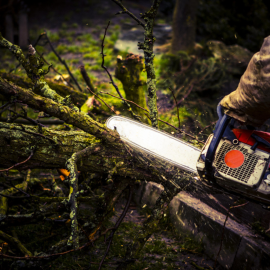Chainsaw common questions


These common questions about chainsaws are the ones our experts hear the most often from our customers. You might also find the help you need by checking the common symptoms and solutions for chainsaws. When you’re ready to make a repair, search your model number to find replacement parts. Sears PartsDirect has the part you need, no matter where you bought your chainsaw.
What ratio of gasoline to oil do I use for my chainsaw?
Refer to the owner's manual for the proper ration of gasoline to oil for your chainsaw. Most models use 40 parts gasoline for each part oil. To get that ratio, add a 3.2 oz. bottle of 2-cycle oil to a gallon of gasoline.
Why won’t my chainsaw start?
Stale fuel causes most starting problems. Empty the gas tank and fill it with fresh fuel or 2-cycle gasoline/oil mix. If the chainsaw still won’t start, the engine might have a clogged carburetor, failed ignition system, or lack of compression.
How do I store my chainsaw for the winter?
It’s important to remove all the fuel in the chainsaw before storing it for the winter; otherwise, the stagnant 2-cycle fuel turns to lacquer and clogs the ports in the carburetor.
First, drain all the fuel and bar oil from the chainsaw. Next, start the chainsaw and allow it to idle with the chain brake disengaged until the engine dies. This procedure purges all the fuel from the engine, carburetor and fuel system.
Allow the chainsaw to cool and then clean it thoroughly. Lightly oil all metal surfaces and the guide bar to prevent rust.
Oil the chain and wrap the chain with a cloth or heavy paper to protect the chain from corrosion.
Store the chainsaw in a clean, dry area.
What types of bar and chain oil can I use in my chainsaw?
Use the type of oil recommended in your owner’s manual. Most chainsaws require standard bar and chain oil. The bar and chain oil contains additives that help the oil adhere to the bar and chain better than regular motor oil.
In a pinch, you can substitute a good grade of SAE 30 motor oil until you can fill the reservoir with the correct bar and chain oil.
Don’t fill the bar and chain oil reservoir with used oil. Used motor oil corrupts the chainsaw’s oiling system.
Can I use E85 fuel in my chainsaw?
E85 contains 85% ethyl alcohol (ethanol) and 15% gasoline. Most chainsaws engines can’t use E85 fuel. Many chainsaws can only use unleaded gasoline with up to 10% ethyl alcohol (E10). Check your owner’s manual for fuel specifications.
Why does my chainsaw pull to one side?
If your chainsaw pulls to one side while cutting, you could have dull cutters on the chain. Sharpen the chain if it’s dull.
A worn guide bar can also cause the chainsaw to drift to the side while cutting. Replace the guide bar if worn.
Uneven depth gauges on the chain teeth can cause the chainsaw to pull to one side. Check the depth gauges and file them to the proper depth and shape if necessary.
How often should I clean the air filter in my chainsaw?
Most manufacturers recommend that you clean the chainsaw air filter after every 5 hours of use. Clean the air filter more often in dusty conditions. During heavy use, clean the air filter every time you fill the fuel tank.
Why does the chain on my chainsaw get dull so fast?
Chains dull quickly when exposed to dirt and sand. Keep the chain and guide bar off of the ground and away from dirt and sand. Clean the chain and guide bar as necessary to remove dirt and sand during use.
Foreign objects such as nails can also dull the chain quickly. Don’t attempt to cut through nails or wire in limbs or trees. Avoid contact with all foreign objects when using the chainsaw.
Is there environmentally friendly chain oil available for chainsaws?
Several manufacturers produce biodegradable chain oil with environmentally safe additives. These alternative chain oils use canola oil or vegetable oil as a base. Additives improve the tackiness of the oil and reduce sling loss.
Using plain canola oil or vegetable oil isn’t recommended because these oils lack additives to prevent sling loss. If you use environmentally friendly chain oil, choose one with proper additives to properly lubricate the chain and guide bar.
Symptoms for gas chainsaws
Choose a symptom to see related chainsaw repairs.
Main causes: cracked fuel lines, leaky carburetor seals, damaged fuel tank cap, cracked fuel tank…
Main causes: bad gas, engine needs tune up, cracked fuel lines, dirty carburetor…
Main causes: stale gasoline, cracked fuel lines, dirty carburetor, damaged spark plug, worn piston rings…
Repair guides for gas chainsaws
These step-by-step repair guides will help you safely fix what’s broken on your chainsaw.

How to rebuild a chainsaw carburetor
If your chainsaw isn't running well, a dirty carburetor could be the problem. You can take it apart, clean it and rebuil…

How to replace a chainsaw carburetor
If the engine won't start even though there's fuel in the chainsaw, the carburetor could be the problem. Sometimes, it's…

How to replace chainsaw fuel lines
The fuel line on a chainsaw becomes brittle over time and can crack. Replacing it doesn't require a lot of DYI experienc…
Articles and videos for gas chainsaws
Use the advice and tips in these articles and videos to get the most out of your chainsaw.

Learn about all the convenient features on our Sears PartsDirect website that make your parts purchases easier.…

Get answers to frequently asked questions about Sears and Sears PartsDirect.…

Learn the basics of taking care of your chainsaw and solving common problems.…